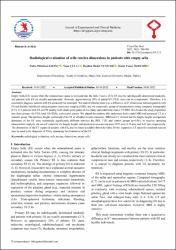Radiological evaluation of sella turcica dimensions in patients with empty sella
Citation
Kilinç, R. M., et al. "Radiological Evaluation of Sella Turcica Dimensions in Patients with Empty Sella." Journal of Experimental and Clinical Medicine (Turkey), vol. 39, no. 3, 2022, pp. 706-709. doi:10.52142/omujecm.39.3.21.10.52142/omujecm.39.3.21.Abstract
Empty Sella (ES) occurs when the subarachnoid space is herniated into the Sella Turcica (ST). ES may be radiologically determined randomly, and patients with ES are usually asymptomatic. However, approximately 20% of partial ES (PES) cases can be symptomatic. Therefore, it is essential to diagnose patients with ES accurately for treatment. We studied whether there was a difference in ST dimensions between patients with ES and healthy individuals using magnetic resonance imaging (MRI), and we compared a group of measurements using computed tomography (CT). 212 patients with ES and 98 healthy individuals participated in this study and underwent cranial 3T MRI. We divided the study population into three groups: the PES, total ES (TES), and control groups. We placed the patients who underwent both cranial MRI and paranasal CT in a separate group. The aperture, height, and length of the ST of all subjects were measured. MRI and CT showed that the length, height, and aperture diameters of the ST were statistically significantly different between the PES, TES, and control groups (p<0.05). In receiver operating characteristic analysis, the cut-off values for the length, height, and aperture measurements were 12.05 mm, 8.35 mm, and 9.65 mm, respectively. The dimensions of the ST expand in patients with ES, and we found a reliable threshold value for this expansion. CT taken for unrelated reasons may be used in the diagnosis of ES by measuring the dimensions of the ST.
Source
Journal of Experimental and Clinical Medicine (Turkey)Volume
39Issue
3URI
https://dergipark.org.tr/en/download/article-file/2202751https://hdl.handle.net/20.500.12809/10419


















